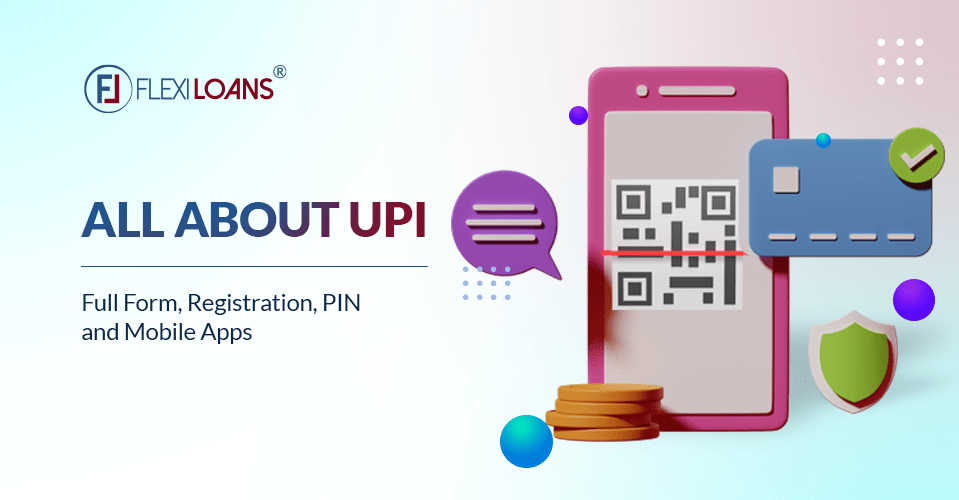Oct 27, 2023
Nov 27, 2025

UPI Payment System
UPI was launched by the National Payments Corporation of India (NPCI) in 2016 to make online transactions faster, cheaper, and more convenient for users. UPI has transformed how people pay and receive money, as it eliminates the need to enter the bank details of the recipient, such as account number and IFSC code. Let’s understand the full form of UPI in banking and other critical UPI-related information.
What is the Full Form of UPI?
The full form of UPI payment is the Unified Payments Interface. It is a technology that allows you to transfer money between different bank accounts using your smartphone. You can also use UPI to pay for various services and goods, such as utility bills, online shopping, and offline stores. The NPCI is responsible for UPI development, and the Reserve Bank of India (RBI) regulates it. UPI is fast, secure, and convenient, working 24/7 throughout the year.
To use the UPI form of payment, you need a smartphone with an internet connection and a bank account linked to your mobile number. You must also download a UPI-enabled app from your bank or a third-party provider.
How does UPI Function?
Here are some steps to explain how UPI works:
- First, you need to download a UPI app from the app store. Many UPI apps are available, such as Google Pay, PhonePe, Paytm, and BHIM. You can choose any app that you like.
- Next, you must create a UPI ID, a unique identifier for your bank account. A UPI ID looks like this: abcdef@ybl or 90876543@okicici. The first part can be your name, email address, or mobile number; the second is your bank’s initials. You can link several bank accounts to a single UPI ID.
- Then, you need to set a UPI PIN, a four- or six-digit code you must enter every time you make a transaction. You can create a UPI PIN by entering your debit card details and verifying your mobile number.
- Now, you are ready to use UPI for sending or receiving money. To send money, you can enter the receiver’s UPI ID and mobile number or scan their QR code. You can share your UPI ID or QR code with the sender to receive money. You may also request money from anyone by sending them a payment request.
- When you confirm the transaction details and input your UPI PIN, your bank account will instantly transfer the money to the receiver’s bank account. You will get a notification on your app and an SMS on your phone about the transaction status.
Is it safe to use UPI?
The NPCI considers UPI the most secure means of making cashless payments. Certain safety factors support this assertion:
- Verification Security: The first element is cell phone number verification during the initial registration. This ties your UPI account with your phone number, transforming it into an identification method. If you update your mobile number, the verification procedure must be restarted.
- If you lose your phone, you can block the number, blocking any future transactions from your bank account. This serves as a safety measure against identity theft.
- Protection During Money transfers: When you sign up, the UPI allows you to create a 4- or 6-digit mobile pin referred to as the MPIN. The MPIN, when once created, can be used to validate every transaction. Since your MPIN is unique to you, no other person can make payments from your account using the app on your phone.
- Protection During Verification of Parties: Another feature of the UPI framework is the ability to authenticate merchant identities to minimize fraud. The QR code and verified intent option let you know whether or not the merchant is UPI-verified. You are promptly notified if any merchant you interact with is not UPI-certified. The danger of QR code tampering is also relatively low, which boosts the trustworthiness of UPI transactions.
Features of UPI
Some of the notable features of UPI are:
- Fast and real-time: UPI enables you to transfer money instantly, 24×7, 365 days a year. It uses the Immediate Payment Service (IMPS) platform, which is a secure and reliable way of sending money online.
- Simple and convenient: UPI simplifies the process of online payments by eliminating the need to enter or remember multiple details such as account number, IFSC code, card number, etc. You can just use your VPA or scan a QR code to make or receive payments.
- Secure and safe: UPI ensures the security and privacy of your transactions by using a two-factor authentication method. You need to enter a personal identification number (PIN) to authorise every transaction. Only you and your bank PIN know the PIN. UPI also encrypts your data and does not share it with anyone else.
- Multiple bank accounts: UPI allows you to link and access various bank accounts through a single app. You can choose which account you want to use for each transaction. You can also check all your linked accounts’ balances and transaction history.
- Request money: UPI is one of the only payment systems that allows you to request money from someone else by sending a message or a notification. This feature is useful for collecting payments from customers, friends, or family members.
- Merchant payments: UPI enables you to pay for various goods and services online or offline using your mobile app. You can pay at e-commerce websites, bill payment portals, grocery stores, restaurants, etc., by scanning a QR code or entering a VPA.
UPI Transaction Limit
The limit varies depending on the transaction type. Here are the details.
- Normal transactions: The UPI daily transaction limit is ₹ 1 lakh for most banks and wallets, according to NPCI. However, some banks may have lower or higher limits. Few banks have capped the limit to ₹ 25,000. Also, the transaction ceiling for merchants and bill payments is ₹ 5 lakhs. The maximum permissible transaction number in a day is 20.
- ATM withdrawals: You can withdraw funds from ATMs using UPI apps. The UPI limit for ATM withdrawals is ₹ 10,000 per day.
- Debt securities: You can use UPI to invest in debt securities like bonds. The UPI limit for such transactions is ₹ 5 lakhs. Earlier, this limit was ₹ 2 lakhs. However, this new rule applies only to debt securities (public issues) open on or after May 1, 2022.
- IPOs: You can use UPI to apply for initial public offerings (IPOs) of companies going public. The UPI limit for IPOs is ₹ 5 lakh per transaction. You need to enter your UPI ID in the application form and approve the mandate request from your UPI app to block the amount for the IPO.
How to Reset UPI ID?
To reset your UPI PIN, you need to have your debit card or Aadhaar card details handy. Here are the steps to follow:
- Open the app you use for UPI transactions, such as Google Pay, PhonePe, Paytm, or BHIM UPI.
- Tap your profile picture or bank account icon in the app’s top right corner.
- Choose the account for which you want to change the UPI PIN.
- Tap on the option that says “Reset UPI PIN”, “Change UPI PIN”, or something similar.
- Input your debit card number and expiry date or your Aadhaar number, depending on the app.
- You will get an OTP on your registered mobile number. Enter the OTP and verify your identity.
- Set a new UPI PIN of your choice. It should be a four-digit or six-digit number that you can remember easily.
- Re-enter the same UPI PIN to confirm it.
Advantages of UPI
UPI benefits vary for different categories. Here is how.
Benefits for Banks
UPI helps banks reduce transaction costs, as they do not have to maintain physical infrastructure or intermediaries for processing payments. UPI also increases the customer base and loyalty of banks, as they can offer their customers a convenient and seamless payment experience. It also enables banks to collaborate with fintech companies and other service providers to offer innovative and value-added services to their customers.
Benefits for Users
It offers you as a user a simple and fast way to pay using mobile phones. You do not need to remember or share your bank account details or card numbers as a user.
Other perks include:
- Advanced security.
- Option to make different kinds of payments.
- Enjoying discounts on a few merchants.
Benefits for Merchants
UPI enables merchants to accept payments from customers without any hassle or delay. Merchants do not need to invest in expensive point-of-sale (POS) machines or swipe machines, as they can simply display a QR code or generate a payment request on their smartphones.
They also do not need to worry about storing or handling cash; they receive the payment directly into their bank accounts. It further helps merchants increase their sales and customer satisfaction by offering discounts and incentives for digital payments. Another benefit is integrating various platforms and applications, such as e-commerce sites, to connect with more customers and expand their business.
Understanding UPI 123Pay
UPI 123Pay is a feature that lets you make payments using your feature phone without needing the internet or a smartphone.
One method to use UPI 123Pay is dialling 99#, also known as USSD based mobile banking service. USSD means Unstructured Supplementary Service Data, which is a communication channel that works on any GSM phone. By dialling 99#, you can access a menu that allows you to perform various banking services, such as checking your balance, sending money, requesting money, changing your UPI PIN, and more.
UPI 123Pay is multilingual. You can select from 13 languages, including Hindi and English, to use the service.
Understanding UPI Lite
UPI Lite is a feature that lets you make small payments of up to ₹ 200 without using a UPI PIN or the internet. You can use UPI Lite on any mobile phone, whether a smartphone or a basic phone.
Steps to Report Wrong UPI Transaction
You can raise a transaction dispute on a PSP app or a Trap app by following these steps:
- Open the app and go to the transaction history section.
- Find the transaction that you want to dispute and tap on it.
- You will see an option to raise a complaint or report an issue. Tap on it and select the reason for your dispute.
- Provide some details like transaction ID, amount, date, time, etc. Fill in the required information and submit your complaint.
- You will get a confirmation SMS and a reference number for your complaint. You can use this number to track the status of your complaint.
- The app will forward your complaint to the respective bank or NPCI for resolution. You will receive the details of the outcome of your complaint within a specified time frame.
In case the person you sent money to does not acknowledge your refund request and the bank can’t recover the funds, you can report the issue through NPCI’s Dispute Resolution Mechanism if you suspect that the wrong UPI ID intentionally received the funds.
Various UPI-Enabled Banks
You will find two types of UPI Enabled Banks. These are:
Banks with UPI apps: These banks have their own UPI apps that allow their customers to link their bank accounts and create UPI IDs. Some examples of these banks are the State Bank of India (SBI), HDFC Bank, ICICI Bank, and Axis Bank.
- Banks with third-party UPI apps: These banks have partnered with third-party UPI apps to provide UPI services to their customers. These banks do not have their own UPI apps but rely on third-party apps to facilitate UPI transactions. Some examples of these banks are Yes Bank, Federal Bank, and Paytm Payments Bank.
There are also some banks that neither have their own UPI app nor have tie-ups with the third party.
How does UPI differ from NEFT and IMPS?
The key distinctions between all three payment methods are as follows
| Parameters | UPI | NEFT | IMPS |
| Regulatory authority | NPCI | RBI | NPCI |
| Settlement type | Immediate clearance | Payments settlement is in half-hourly batches | Quick settlement |
| Minimum transfer limit | ₹ 1 | ₹ 1 | ₹ 1 |
| Maximum limit | ₹ 1 lakh | No maximum limit | ₹ 2 lakhs |
| Service accessibility | Online and offline | Online and offline | Only online |
| Charges | Nil | Nil for online transactions | Vary from one financial institution to the next |
Conclusion
UPI is a digital payment revolution that has transformed how people pay and get paid in India. It has brought convenience, speed, security, and innovation to the digital payment ecosystem. UPI has also contributed to the vision of Digital India, which aims to create a cashless and inclusive society.
FAQs
You can call on 022-45414740 or 1800-1201-740 to get UPI-related assistance.
The full form of UPI in banking is the Unified Payments Interface.
VPA full form is Virtual Payment Assistance. It is a unique identifier that assists UPI in tracking your account.
It is a password that you will need at the time of transferring funds through UPI.
You don’t have to pay anything while transferring funds using UPI.
No. The only similarity between them is their developer, NPCI. BHIM is an app, while UPI is a platform that facilitates funds transfer from one bank account to another.
The maximum transfer limit is ₹ 1 lakh in a day, with the maximum number of transactions restricted to 20.
Yes. You cannot transfer money or avail of other services if no bank account is linked to your UPI system. Another thing to note here is you can only link savings accounts here.







